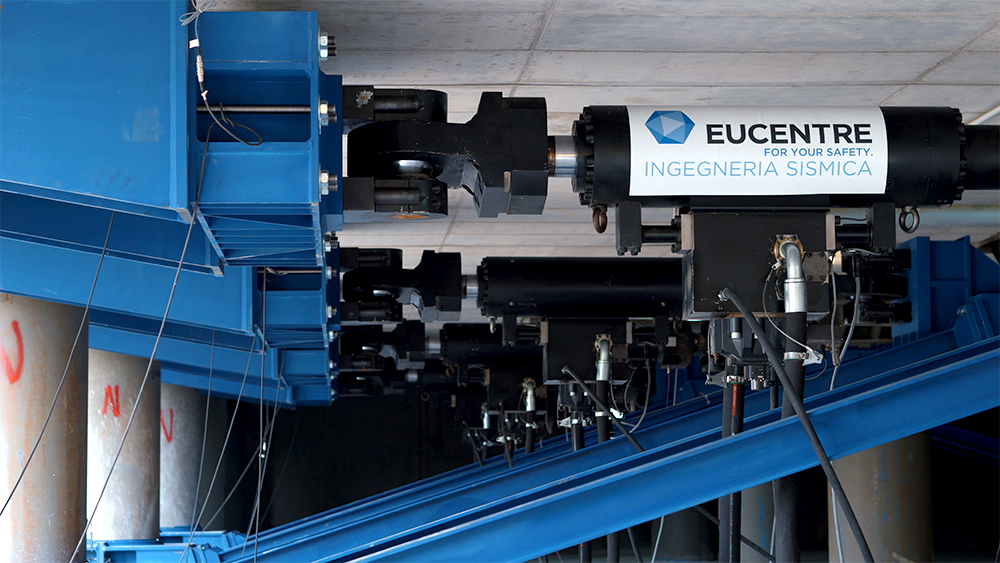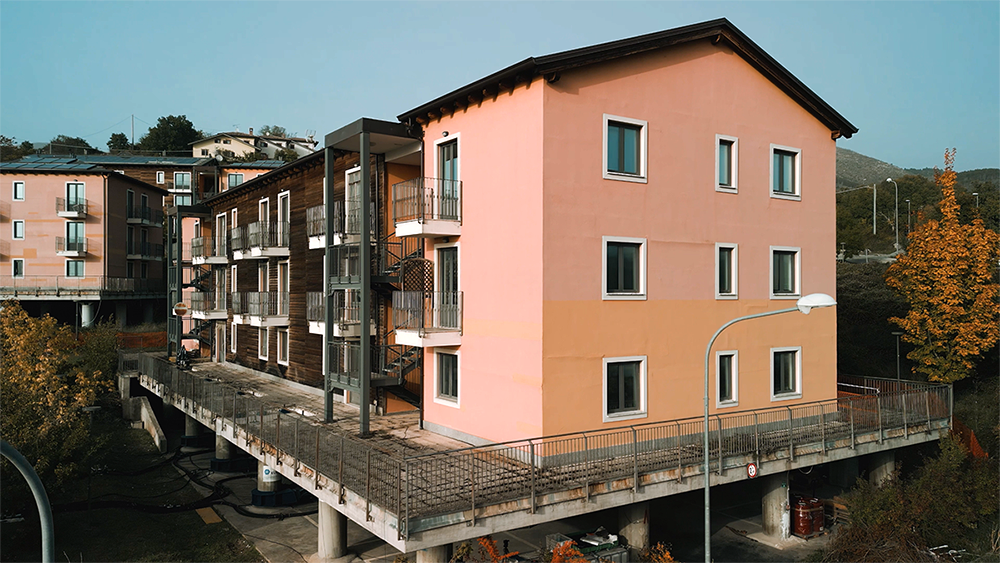Fondazione Eucentre, in collaborazione con l’Università di Washington (Seattle, USA), l’Università di Berkeley (California, USA) e la Middle East Technical University (Ankara, Turchia), ha condotto nel mese di ottobre 2024 ad Arischia, frazione del Comune dell’Aquila, una sperimentazione senza precedenti. Un intero edificio esistente, con un peso di circa 2000 tonnellate, è stato sottoposto a una serie di test dinamici, nell’ambito del progetto ERIES finanziato dalla Commissione Europea e coordinato dalla Scuola Universitaria Superiore IUSS di Pavia. Questo tipo di prove sismiche, fino ad oggi svolte principalmente per provini di dimensioni medio-piccole su tavole vibranti all’interno di laboratori sperimentali, sono state per la prima volte eseguite su un edificio reale, rappresentando quindi un importante passo avanti nella ricerca sulla gestione e mitigazione del rischio sismico.
Sistema di Isolamento Sismico: Struttura e Funzionamento
Lo schema strutturale del Progetto C.A.S.E. si compone, dal basso verso l’alto, da una piastra in calcestruzzo armato (CA) a terra, una serie di colonne in acciaio o in CA, un isolatore sismico su ciascuna colonna e, al di sopra, una seconda piastra di fondazione, sulla quale è realizzato l’edificio. Il sistema di isolamento consente, in caso di evento sismico, lo spostamento relativo tra le colonne e la piastra di fondazione superiore, pur mantenendo la capacità portante nei confronti dei carichi verticali. Questo sistema riduce significativamente le accelerazioni trasmesse alla sovrastruttura, proteggendo così l’edificio da danni strutturali.
Test della risposta sismica di un edificio reale
Un primo test ha avuto come obiettivo quello di valutare il comportamento sismico di un intero palazzo, scelto tra i 185 edifici sismicamente isolati costruiti nell’ambito del progetto C.A.S.E. in risposta al terremoto dell’Aquila del 6 aprile 2009. L’edificio è stato sottoposto a delle sollecitazioni sismiche registrate in eventi passati, applicate direttamente sulla piastra di fondazione superiore del fabbricato, consentendo quindi di studiare il comportamento della struttura come se fosse realizzata in configurazione non sismicamente isolata. Il risultato della prova ha permesso di raccogliere importanti dati sulla risposta sismica di questo edificio, che di fatto non ha riportato danni strutturali particolari, nonostante le azioni sismiche superiori a quelle considerate nella sua progettazione originale.
Test dinamico del sistema di isolamento alla base
Questa seconda prova ha previsto un test ciclico ad alta velocità che coinvolge tutti i 32 isolatori a pendolo scorrevole installati sotto la piastra di fondazione superiore dell’edificio a protezione del palazzo dalle sollecitazioni sismiche. Il sistema di isolamento è stato quindi sottoposto a diversi cicli di carico in spostamento di ampiezza ±20 cm, imposti sulla piastra di fondazione superiore con una velocità intorno a 30 cm/s. Il test ha fornito dati preziosi e unici nel mondo sulla capacità di questi dispositivi di mantenere prestazioni adeguate anche a distanza di 15 anni dalla loro installazione.
 Eucentre è una Fondazione di diritto privato senza scopo di lucro che persegue una missione di ricerca, formazione e erogazione di servizi nel settore dell’ingegneria sismica e, più in generale, dell’ingegneria della sicurezza
Eucentre è una Fondazione di diritto privato senza scopo di lucro che persegue una missione di ricerca, formazione e erogazione di servizi nel settore dell’ingegneria sismica e, più in generale, dell’ingegneria della sicurezza  Eucentre promuove Scienza, Ricerca e Innovazione a beneficio della collettività, offrendo metodologie mirate e soluzioni concrete per prevenzione, sicurezza e resilienza. Collabora con istituzioni e imprese, diffondendo competenze orientate al vantaggio comune.
Eucentre promuove Scienza, Ricerca e Innovazione a beneficio della collettività, offrendo metodologie mirate e soluzioni concrete per prevenzione, sicurezza e resilienza. Collabora con istituzioni e imprese, diffondendo competenze orientate al vantaggio comune. Tavole vibranti
Tavole vibranti Altri sistemi di prova
Altri sistemi di prova Eucentre conduce attività di ricerca su ingegneria sismica e riduzione del rischio, attraverso prove di laboratorio e analisi numeriche, per migliorare il comportamento sismico di strutture e terreni e sviluppare tecniche innovative di consolidamento antisismico.
Eucentre conduce attività di ricerca su ingegneria sismica e riduzione del rischio, attraverso prove di laboratorio e analisi numeriche, per migliorare il comportamento sismico di strutture e terreni e sviluppare tecniche innovative di consolidamento antisismico. La Fondazione promuove attività formative diversificate e di alta qualità, rivolte a contesti accademici e professionali, con programmi e iniziative costantemente aggiornati e innovativi per rispondere alle esigenze in continua evoluzione del settore e della società
La Fondazione promuove attività formative diversificate e di alta qualità, rivolte a contesti accademici e professionali, con programmi e iniziative costantemente aggiornati e innovativi per rispondere alle esigenze in continua evoluzione del settore e della società  Eucentre assicura una comunicazione per informare istituzioni, professionisti e cittadini sulle attività e i progetti in corso, con l’obiettivo di diffondere contenuti e conoscenze utili e accessibili a tutti. Contribuisce a promuovere una cultura della prevenzione e della resilienza, condivisa e consapevole.
Eucentre assicura una comunicazione per informare istituzioni, professionisti e cittadini sulle attività e i progetti in corso, con l’obiettivo di diffondere contenuti e conoscenze utili e accessibili a tutti. Contribuisce a promuovere una cultura della prevenzione e della resilienza, condivisa e consapevole.




